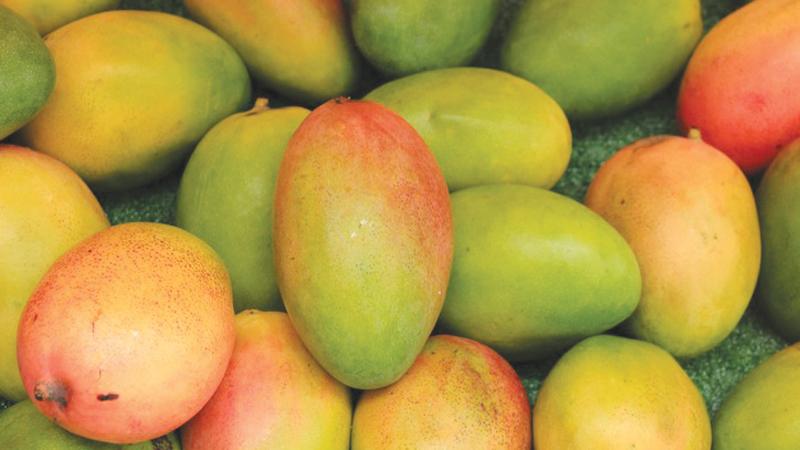
Mango (Mangiferaindica L.) is a fruit of the genus Mangifera. The genus Mangifera belongs to the Anacardiaceae family. The genus Mangifera contains some 69 different species, with mango being the most common.
Mango is considered a tropical fruit believed to have originated in Asia. China, India, Brazil, Nigeria, Pakistan, Mexico, Thailand and the Philippines are famous for mango cultivation, while India and China are the two largest mango producers. World mango production is about 58 million metric tons per year. The mango is the national fruit of India, Pakistan and the Philippines. Mango tree is the national tree of Bangladesh.
Around 1,000 varieties of mangoes are cultivated worldwide. It is known by various names around the world, for example, Manja/u in Arabic, Mannko in Greek, Am or Ambi in Hindi, Amba in Sinhala, Mangue in French, Mango in Finnish, Mango in Dutch, Mangue in German, Mánggu in Chinese, and Mampalam in Tamil. Ripe and raw mangoes are used in human consumption as pickles, juices, oils, honey, dried powder, sauces, and jams.
Nutrients
 Mango peel and flesh are reported to be rich in fibre, vitamin C and A, amino acids and polyphenols. In addition to the widespread use of mango fruit as a food item, various parts of the mango tree (bark, leaves, roots, fruits, and flowers) have also been used ethnomedicinally by various countries for various medicinal purposes since ancient times. The table below summarises how different parts of the mango tree (bark, leaves, roots, fruits and flowers) have traditionally been used by different countries for various medicinal purposes.
Mango peel and flesh are reported to be rich in fibre, vitamin C and A, amino acids and polyphenols. In addition to the widespread use of mango fruit as a food item, various parts of the mango tree (bark, leaves, roots, fruits, and flowers) have also been used ethnomedicinally by various countries for various medicinal purposes since ancient times. The table below summarises how different parts of the mango tree (bark, leaves, roots, fruits and flowers) have traditionally been used by different countries for various medicinal purposes.
Many different chemical compounds have been reported in mangoes. Of these, polyphenols (flavonoids, xanthones and phenolic acids) are the most abundant natural compounds. Examples of polyphenols in mango are compounds such as mangiferin, gallic acid, catechins, quercetin, kaempferol, protocatechuic acid, ellagic acids, propyl and methyl gallaterhamnetin.
The amount of different polyphenols in mango depends on the portion and variety of mango. Carotenoids are another class of natural compounds found in this plants. They are also considered as natural organic pigments. Carotenoids have been found to cause the bright yellow colour of mango peels and flesh.
Luteoxanthin, violaxanthin, neoxanthin, zeaxanthin, and cryptoxanthin are the major carotenoids found in mango peels and flesh. It also contains various terpenoids. Of these, the terpenoids ocimene, terpinolene, myrcene and limonene occupy a special place. Many of these terpenoids are volatile and help with the odour of mangoes. Mango is rich in natural compounds called resorcinolic lipids or phenolic lipids.
Here are some examples of bioactive compounds found in different parts of the mango plant (Source: Ediriweera et al., 2017)
Leaves: Amino acids such as lanine, glycine, valine, tyrosine, leucine, and g-aminobutyric acid. Polyphenols and phenolic acids include protocatechuic acid, gallic acid, hyperin, catechin, quercetin, mangiferin, kainic acid, ethyl digallate, ellagic acid, and shikimic acid. Alcohols include methylic, ethyl, and isobutyl alcohols. Terpenes include a-pinene, b-pinene, d-elemene, taraxerol, b-elemene, a–cubebene, camphene, g–cadinene, lupeol, friedelin, linalool, b-bulnesene, a-guaiene, humulene, a-farnesene, myrcene, car-3-ene, limonene, b-ocimene, g–terpinene, and a-terpinolene. Phenylpropenes include estragole, methyleugenol and elemicin. Sterols include a, b, and g-sitosterol.
Fruit Peel and Flesh: Triterpenes and triterpenoids include cycloartenol, a-amyrin, b-amyrin, ocotillol, 3b-hydroxycycloart-24-en-26-al, 24-methylene-cycloartan-3b, 26-diol, dammarenediol II, and psi-taraxastane-3b. Polyphenols and phenolic acids include ascorbic acid, quercetin, mangiferin, quercetin 3-ara, quercetin 3-rha, isomangiferingallate, mangiferin gallate, methyl mangiferonate, methyl mangiferolate, tetra-O-galloylglucose, hexa-O-galloylglucose, methyl isomangiferolate, caffeic acid, ferulic acid, gallic acid, cinnamic acid, vanillin, rhamnetin-3-O-galactoside, kaempferol, and kaempferol-hexose. Resorcinolic lipids include 5-(11′Z-heptadecenyl)-resorcinol and 5-(8Z, 11Z-heptadecadienyl)-resorcinol. Carotenoids include b-carotene, cis-violaxanthin, neochrome, cis-neoxanthin, luteoxanthin, zeaxanthin, and 9- or 9cis-lutein.
Long-chain fatty acids include oleic acid, linoleic acid, linolenic acid, and n-pentacosanol.
Root: Triterpenes and triterpenoids include friedelin, friedelan-3b-ol and cycloartenol. Sterols include -sitostero and 3-methoxy-2-(4-methyl benzoyl)-chromone.
Bark: Polyphenols and phenolic acids include protocatechuic acid, catechin, mangiferin, benzoic acid, kainic acid, gallic acid, shikimic acid, and kaempferol. Triterpenes and triterpenoids include cycloart-24-en-3b, 26-diol, 3-ketodammar-24(E)-en-20S, 26-diol, friedelin, mangocoumarin, manglupenone, manghopanal, cycloartan-3b-30-diol cycloartan-3b, 24, 27-triol, mangoleanone, mangiferolic acid ethyl ester, mangiferolate A and mangiferolate B, and 29-hydroxymangiferonic acid. Halogenated amide includes 3-chloro-N-(2-phenylethyl) propenamide.
Pharmacological properties
Long-chain hydrocarbons include N-triacontane, N-tetracosane, and 9, 12-tetradecadiene-1-ol-acetate. Terpenoid saponins include indicoside A and B. Amino acids include alanine, glycine, and g-aminobutyric acid. Numerous studies have been conducted all over the world to show the medicinal activities associated with different parts of the mango plant.
Organic extracts from various parts of the mango plant and various mango derived compounds have been used for this purpose.
For example, organic extracts obtained from various parts of the mango plant have been reported to exert anticancer, anti-inflammatory, antidiabetic, antioxidant, antibacterial, antifungal, anthelmintic, gastroprotective, hepatoprotective, immunomodulatory, antiplasmodial, and antihyperlipemic activities.
Source: Ediriweera, M.K., Tennekoon, K.H. and Samarakoon, S.R., 2017. A review on ethnopharmacological applications, pharmacological activities, and bioactive compounds of Mangiferaindica (mango). Evidence-Based Complementary and Alternative Medicine, 2017.

